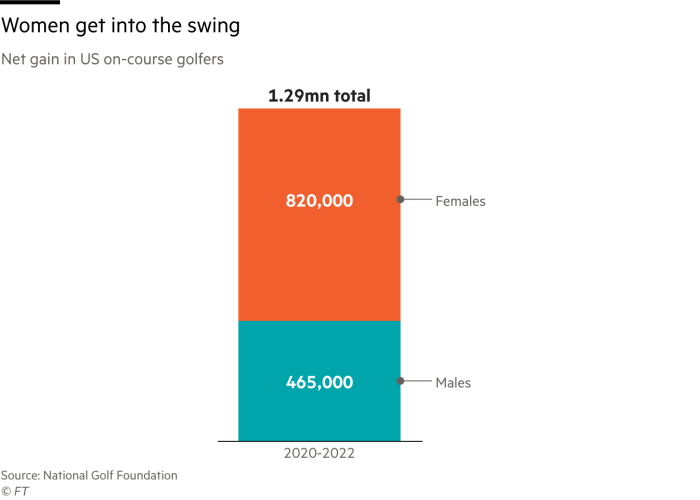Female interest in golf continues to rise post-Covid

Roula Khalaf, Editor of the FT, selects her favourite stories in this weekly newsletter.
When Ruoning Yin drained a birdie on the 18th hole to win the KPMG Women’s PGA Championship at New Jersey’s Baltusrol Lower Course in June, it underlined China’s emergence as a golfing power.
And the fact that second place at one of the LPGA’s five majors was secured by Japan’s Yuka Saso, with Lin Xiyu of China third, seemed to confirm Asia’s pre-eminence of the sport. Asian players now dominate the top 10 of the women’s world golf rankings.
This growing Asian influence had been stoking some anxiety in Europe and the US that the game was losing appeal in its traditional heartlands. But the sport did receive a timely boost from the most unlikely source: Covid-inspired lockdowns.
Golf proved the ideal pursuit when governments insisted that citizens only exercise in family bubbles and observe social distancing. In the US, the biggest golf market in the world worth $84bn, the number of golfers rose from 24.3mn in 2019 to 25.6mn in 2022.
The biggest gain was among female golfers, with the number of women playing the game jumping 15 per cent (820,000) compared with a 2 per cent (460,000) rise among men, according to the National Golf Foundation. Even with pandemic restrictions lifted and more sporting and leisure options becoming available, the numbers appear to be holding up. Women golfers now make up 25 per cent of all players in the US.

The NGF says progress in the women’s game has been driven, in part, by junior development programmes with a female focus. Girls represent 38 per cent of all golfers under the age of 18. When the organisation first began tracking participation in 1986, girls made up just 14 per cent of golfers.
There has also been a big effort to make golf more welcoming and affordable. In June, the LPGA and Walmart teamed up to offer entry-level clubs for women. A junior set with a bag starts at $99 while an eight-piece adult set is available for $199.
In Great Britain and Ireland, the pandemic helped bolster playing numbers, too. According to the R&A, the body that governs golf everywhere outside of the US and Mexico, 5.6mn adults played on a nine-hole or 18-hole golf course in 2022.
That is the second-highest number since monitoring began more than 30 years ago. More significantly, 20 per cent of adult golfers on full-length courses were female in 2022, compared with 15 per cent in 2019.

But that rise in female participation has not been witnessed at some private clubs. According to Jenny Kay, Lady Captain at Dulwich and Sydenham Hill Golf Club, a private members club south of London, women make up just 11.5 per cent of members with an average age of 61.
Kay believes the perception that golf is both elitist and expensive is putting girls and young women off the game in the UK. The use of the term “ladies golf” as opposed to “women’s golf”, she says, reveals just how out of touch the game can be.
Kay clearly cares deeply about golf. The game animates her, and she is keen for more women to play.
She took up the game 20 years ago in her forties when she was able to play regularly on Saturday mornings, and she wants other women to “discover the joy of golf”.
“Obviously, some of the language around golf has to change,” she says. “The game, though, is not elitist. It’s for people from all walks of life.”
But Kay accepts that there are significant obstacles to women taking up the game. Public golf courses in the UK are closing, she notes, while private clubs can be intimidating.
Golf also demands a considerable time commitment from women juggling careers and families — an 18-hole round takes about four hours. She feels that encouraging women to play shorter rounds of nine holes would help, as well as offering lessons and support while learning the game.
Affordability can be a problem, too. At Royal Blackheath Golf Club, for instance, a weekday round costs £100 for visitors and many of its weekend tee-off slots are reserved for members.
While some golf analysts believe member-run clubs are resistant to change, Kay is determined to attract more women golfers and has an ambition of achieving 30 per cent female membership by 2030.
At Dulwich, 108 children participated in Colt and Golf Access programmes — 39 per cent of whom were girls. The club also had 13 girls take part in England Golf’s “Girl Golf Rocks” programme, which introduces females aged five to 18 to the game in a “fun and friendly way”. The organisation is the governing body for male and female amateur golf in England.
The progress outside private clubs has been swifter. Richard Payne, a director at Sporting Insights, a consultancy, estimates that 30 per cent of all golfers across Great Britain and Ireland in 2023 are female. “The number of female golfers taking up the sport has risen significantly since the pandemic,” says Payne. “And it looks positive that it will continue to grow.”
Kay is thrilled by the rise in women’s participation.
“Golf is such a wonderful game for all women at all stages of their life,” she says. “It would be marvellous if more women took up golf and experienced it for themselves.”

Comments